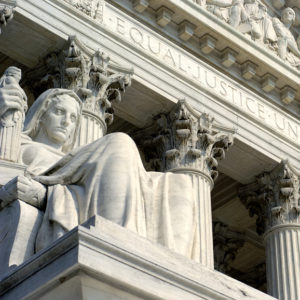EDITOR’S NOTE: For another viewpoint, please see Counterpoint: Progressives, Pack the Courts!
The U.S. Supreme Court has never been an institution that wins popularity contests. Yet going into 2020, we need to rely on the court’s credibility, perhaps more than ever.
In most presidential election cycles, the Supreme Court is a subject of some debate but is rarely atop the list of hot topics. In 2016, it felt different, and even more so now with the 2020 election looming in the shadow of an impeachment inquiry.
Suddenly, books and commentary are everywhere about how the Supreme Court has become too political. “Has the Supreme Court lost its legitimacy?” asked a commentary last February on the NBC News website. “Can The Supreme Court Stay Above The Partisan Fray?” asked the website FiveThirtyEight in an August 2019 article.
As a nation we cannot afford to let the Supreme Court lose its credibility. With Congress paralyzed by partisan gridlock and the presidency mired in controversy, we have to trust in the Supreme Court. We have no choice.
That is why justices of different ideologies insist that the Supreme Court has not become partisan and should not be perceived that way.
“I think it would be very hard to tell a story of a politicized court,” Justice Elena Kagan said in an October appearance at the University of Minnesota. Referring to the last term of the court, she said, “The 5-4 cases that we had were 5-4 in all kinds of different ways, often with lots of people doing unexpected things.”
In an October 2018 appearance at Princeton University, Justice Sonia Sotomayor said that for the court to function, “we have to rise above partisanship in our personal relationships.”
Chief Justice John Roberts expressed a similar view in a September appearance in New York City. “When you live in a polarized political environment, people tend to see everything in those terms,” said Roberts at the Streicker Center of Temple Emanu-El. “That’s not how we at the court function and the results in our cases do not suggest otherwise,” Roberts said.
These words might seem hollow were they not expressed from all sides of the court’s jurisprudential spectrum.
Recent polling suggests that people understand that strong differences among the justices in their decisions do not mean the court is being partisan. An extensive nationwide survey by Marquette Law School in September 2019, showed more confidence in the Supreme Court than in other institutions of government — 37 percent had substantial confidence in the court and an additional 43 percent had some confidence. Among the branches of the federal government, the Supreme Court rated highest for trust level, 57 percent, compared to 22 percent for Congress and 21 percent for the presidency.
To be sure, these days it is not easy to defend the Supreme Court as being above partisan politics.
With the arrival of Justice Brett Kavanaugh just over one year ago, Republicans are cheering the conservative court for which they have been waiting 50 years, since Richard Nixon mounted his “law and order” campaign in 1968. Donald Trump campaigned in 2016 by, among other things, releasing a list of potential Supreme Court nominees that captured the imagination of conservatives and thrust the future of the Supreme Court more directly into the debate.
Democrats, in contrast, are lamenting a court they say is the most partisan and political they have seen, questioning its legitimacy, calling for reforms like term limits and an ethics code, and some vowing to pack an enlarged court with liberals if they get the chance. They are angry that the Republican-controlled Senate blocked any consideration in 2016 of President Barack Obama’s nomination of respected Judge Merrick Garland to replace Justice Antonin Scalia, who died in February 2016.
All of this partisan activity is about the court. It is not the court, itself. The court continues to issue about 65 full decisions each term. In the term that ended in late June, 39 percent of the decisions were unanimous and 7 percent had only one dissenting vote. Those markers of a high level of agreement were lower than in the past decade; the percentage of 5-4 decisions, 28 percent, was one of the highest levels in this decade. But that is not surprising when there is a new justice in his first term and another, Neil Gorsuch, only in his second term.
There have always been decisions that deeply divide the justices. They will come more frequently as the court grows more conservative in judicial philosophy. Even some that appear political, like closing the federal courts to gerrymandering claims, may reflect differences in views of the proper role of the courts, and should not be automatically written off as partisan.
When everything else around us has become partisan, even a divided Supreme Court may be the last hope for democratic principles.

